Scottish Study of Early Learning and Childcare: Three-year-olds (Phase 3) Report - Updated 2021
Findings from the third phase of the Scottish Study of Early Learning and Childcare (SSELC), a research project established to evaluate the expansion of early learning and childcare in Scotland.
This document is part of a collection
Parent outcomes
Economic activity
One of the principal aims of the expansion of ELC provision is to increase the opportunities parents have to work, study or train. Parents and carers were asked about their current economic activity and about any effect the current provision of childcare had on it. The baseline data reported here will be compared with data collected after the increase in funded hours has been rolled out to all three- and four-year-olds, to allow an assessment of the impact of the expansion programme on this aim.
Figures for the parents of the Eligible 2s may differ from those reported earlier. The figures examining how things had changed for the Eligible 2s were based on those who had completed a parent questionnaire at both Phase 1 and Phase 3 of the study. The figures reported in this section are for those who had completed a parent questionnaire at Phase 3. At Phase 1 the keyworker observations only were completed for some of this group.
It is worth keeping in mind when reading this analysis that most of the respondents were female (91% of the Eligible 2s and 93% of the Comparator 3s). While this does not affect any comparisons between the two groups, levels of employment and attitudes towards childcare will be more reflective of women than of men.
Parents were asked whether they had ever had a job, either as an employee or self-employed. The majority of parents in both groups had been employed at one point, with those in the Comparator 3s (97%) more likely to have been employed than those in the Eligible 2s (80%). Among the Eligible 2s those in two parent households (87%) were more likely to have been employed in the past than single parents (75%).
Parents were then asked about their economic activity in the past seven days. Responses are summarised in Table 6.
| What were you doing last week, that is the seven days ending last Sunday? | Eligible 2s | Comparator 3s |
|---|---|---|
| % | % | |
| Working 30 or more hours a week (including if currently on leave or sick) | 9 | 28 |
| Working fewer than 30 hours a week (including if currently on leave or sick) | 29 | 41 |
| On maternity/parental leave from an employer | 2 | 7 |
| Looking after home or family | 63 | 53 |
| Waiting to take up paid work already obtained | 2 | 0 |
| Out of work and looking for a job | 8 | 4 |
| Out of work, because of long-term sickness or disability | 10 | 3 |
| On a Government training or employment scheme | - | - |
| In full-time education (including on vacation) | 5 | 3 |
| In part-time education (including on vacation) | 4 | 3 |
| Wholly retired | 1 | - |
| Not in paid work for some other reason | 11 | 4 |
| Unweighted base | 262 | 563 |
Base: All respondents (parent questionnaire Phase 3, Eligible 2s unweighted, Comparator 3s weighted)
Note: respondents were able to choose more than one response. As such, percentages will not total 100%.
Parents (mostly mothers) in the Comparator 3s group were much more likely to have been working in the past 7 days than those in the Eligible 2s. Two thirds (69%) of parents of the Comparator 3s had been working, including 28% full-time and 41% part-time, compared with 38% of the Eligible 2s (9% full-time and 29% part-time). Looking after the home or family was reported more often by the Eligible 2s (63% compared with 53% of the Comparator 3s), as were most of the other reasons for not being in employment.
Table 7 shows that, of those who described themselves as looking after their home or family, a higher proportion of the Comparator 3s (62%) reported combining this with employment than the Eligible 2s (27%). However, when we look at this the other way around the proportions of those who are in employment who also reported looking after the home or family are fairly similar in the two groups: 34% of the Comparator 3s and 25% of the Eligible 2s who were working full-time reported looking after the home or family, and 51% of the Comparator 3s and 46% of the Eligible 2s who were working part-time also reported looking after the home or family. Small proportions in both groups also combined work and / or looking after the home or family with education.
| Those who describe themselves as looking after the home or family | |||||
|---|---|---|---|---|---|
| Only looking after home or family | Also in education | Also in employment | Also in both employment and education | Unweighted base | |
| % | % | % | % | ||
| Eligible 2s | 69 | 4 | 24 | 3 | 166 |
| Comparator 3s | 34 | 4 | 58 | 4 | 296 |
| Those who describe themselves as in full-time employment (30+ hours / week) | |||||
| Only in FT work | Also in education | Also looking after the family | Also both in education and looking after the family | Unweighted base | |
| % | % | % | % | ||
| Eligible 2s | 71 | 4 | 21 | 4 | 24 |
| Comparator 3s | 66 | - | 28 | 5 | 164 |
| Those who describe themselves as in part-time employment (< 30 hours / week) | |||||
| Only in PT work | Also in education | Also looking after the family | Also both in education and looking after the family | Unweighted base | |
| % | % | % | % | ||
| Eligible 2s | 46 | 8 | 42 | 4 | 76 |
| Comparator 3s | 48 | 1 | 49 | 2 | 223 |
Base: All respondents who reported themselves to be looking after the home or family; to be in full-time employment; and to be in part-time employment (parent questionnaire Phase 3, Eligible 2s unweighted, Comparator 3s weighted)
Parents who were in employment were asked if they would work more if they could afford good quality childcare. Figure 29 shows that those in the Eligible 2s group were more likely to agree (53% in total – 28% strongly agree and 24% agree) than those in the Comparator 3s (34% in total – 15% strongly agree and 18% agree). These numbers were similar when only part-time workers were considered.
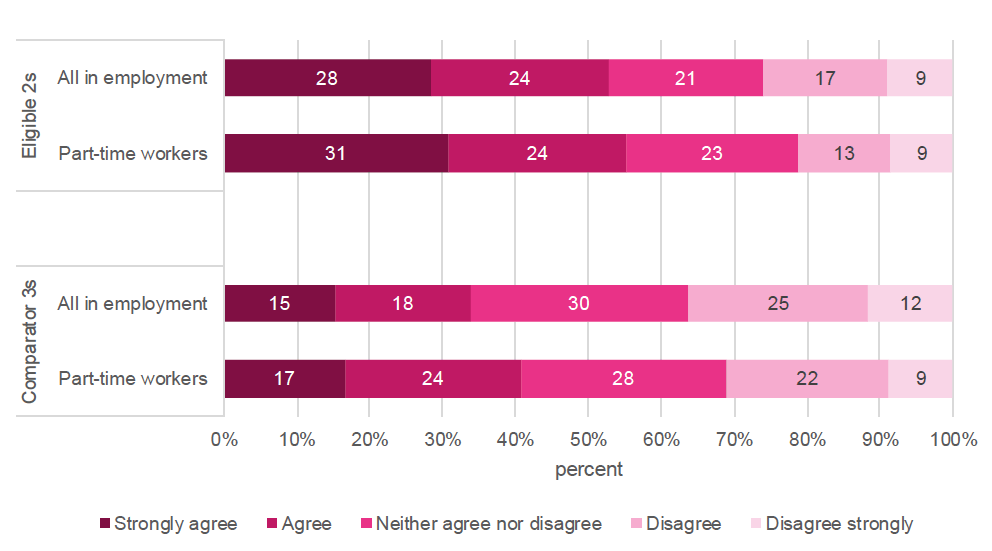
Base: All respondents in employment (parent questionnaire Phase 3, Eligible 2s unweighted, Comparator 3s weighted)
Figure 29: Whether respondent would work more if they could afford childcare, Eligible 2s and Comparator 3s, in employment and in part-time employment, Phase 3 Description. This stacked bar chart shows that 28% of the Eligible 2s group strongly agreed and 24% agreed that they would work more if they could afford good quality childcare, compared with 15% of the Comparator 3s who strongly agreed and 18% agreed.
Among the Comparator 3s, agreement was more likely for those on lower incomes. More than half of the working parents in the lowest income quintile (53%) agreed or strongly agreed that they would work more if they could afford good quality childcare, compared with a quarter (26%) in the top three income quintiles (see Appendix C Table C19).
A similar question was asked of those who were not currently in work or training, namely whether they were not working because of a lack of childcare. The responses are summarised in Figure 30.
Results were broadly similar across the two groups, with more respondents disagreeing that a lack of affordable, convenient and good quality childcare was one of the main reasons they were not working. Almost half of the Eligible 2s (47%) and Comparator 3s (45%) disagreed in total, while a quarter agreed (26% of the Eligible 2s and 25% of the Comparator 3s).
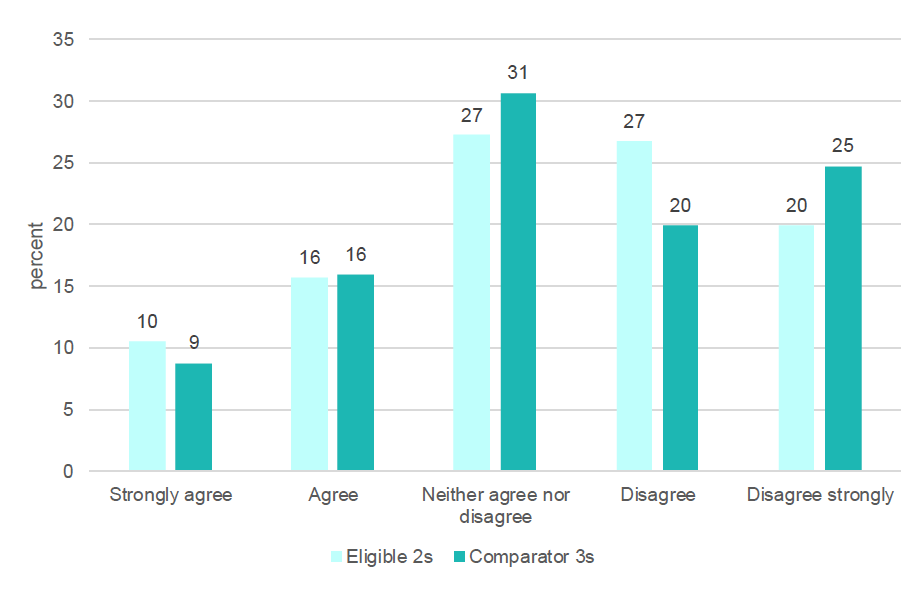
Base: All respondents not in employment (parent questionnaire Phase 3, Eligible 2s unweighted, Comparator 3s weighted)
Figure 30: Whether respondent is not working because of a lack of affordable, good quality childcare, Eligible 2s and Comparator 3s, Phase 3 Description. This clustered column chart shows that 10% of the Eligible 2s group strongly agreed and 16% agreed that they were not working because of a lack of affordable, good quality childcare, compared with 9% of the Comparator 3s who strongly agreed and 16% agreed.
Parental health and wellbeing
General health
As well as being asked about their child's health, parents were asked to assess their own health. The majority of parents in both groups reported being in good or very good health, although the proportion doing so among the Comparator 3s (83%) was higher than that among the Eligible 2s (63%). One in twelve (8%) parents of the Eligible 2s rated their health as bad or very bad. The full results are shown in Figure 31.
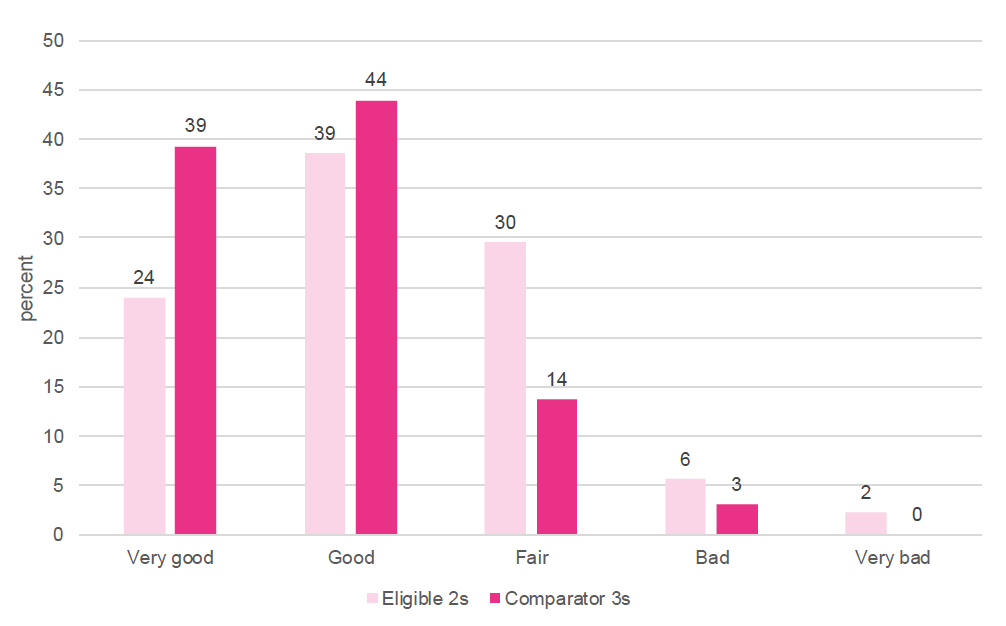
Base: All respondents (parent questionnaire Phase 3, Eligible 2s unweighted, Comparator 3s weighted)
Figure 31: General health, Eligible 2s and Comparator 3s, Phase 3 Description. This clustered column chart shows that 24% of parents of the Eligible 2s and 39% of the Comparator 3s rated their health as very good, while 39% and 44% rated their health as good. 8% of parents of the Eligible 2s rated their health as bad or very bad, compared with 3% of Comparator 3s.
Among the Comparator 3s, those in two parent households, those on higher incomes and those with a higher level of education were all more likely to rate their health as good or very good. Similar patterns could be seen for the Eligible 2s, although they were not quite as strong. Figure 32 shows that 90% of the Comparator 3s parents in the top three income quintiles rated their own health as good or very good, compared with 62% for those in the bottom income quintile.
Figures broken down by level of education and household type are shown in Tables C20 and C21 in Appendix C. Nine out of ten (91%) parents with a degree among the Comparator 3s rated their own health as good or very good, decreasing with decreasing levels of education to 71% of parents with only lower school qualifications. For the Eligible 2s, 74% of parents with a degree rated their health as good or very good, while between 53% and 63% rated their health good or very good among those with lower levels of education.
Single parents were less likely to describe their health as good or very good than couple parents, and this difference was again more marked among the Comparator 3s: 86% of couple parents in the Comparator 3s group rated their health as good or very good, compared with 71% of single parents who did so. The equivalent figures for the Eligible 2s were 66% and 60% respectively.
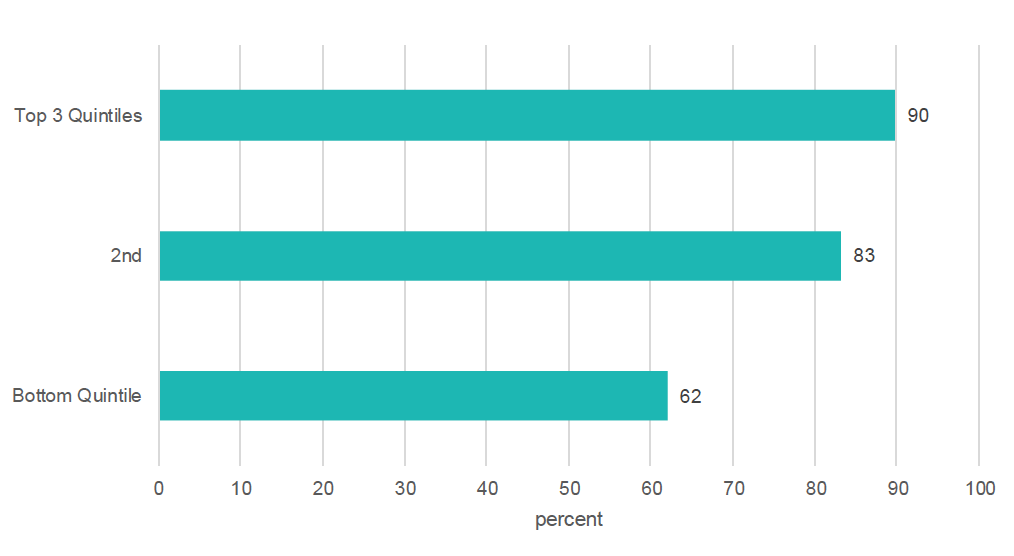
Base: All respondents (parent questionnaire Phase 3, Comparator 3s weighted)
Figure 32: Proportion in good or very good health, by equivalised household income, Comparator 3s, Phase 3 Description. This clustered bar chart shows that 90% of the Comparator 3s parents in the top three income quintiles rated their own health as good or very good, compared with 83% in the 2nd income quintile and 62% for those in the bottom income quintile.
Parents were also asked if they had any physical or mental health conditions lasting or expected to last for 12 months or more, and whether this limited their activities. Parents in the Eligible 2s group were more likely to have a longstanding condition (41%, including 37% with a limiting longstanding condition) than those in the Comparator 3s (20%, including 14% with a limiting condition). For both groups, the most common way in which they were affected by the condition was with mental health, social, emotional or behavioural issues (75% of the Eligible 2s with a condition and 64% of the Comparator 3s with a condition). Other ways in which parents were affected by the condition are listed in Table C22 of Appendix C.
Those in single parent households were more likely to have a longstanding illness than those in couple parent households, 29% of single parents in the Comparator 3s had a longstanding illness compared with 18% of couple parents, while for the Eligible 2s these figures were 43% and 38% respectively. As with general health, the proportion with a longstanding condition among the Comparator 3s declined with increasing levels of income and education (Appendix C Tables C23, C24 and C25).
Wellbeing
The Warwick-Edinburgh Mental Wellbeing Scale (WEMWBS) is an established survey instrument for examining differences in population mental wellbeing in adults. It is not used as a clinical assessment tool, so scores on the scale have no meaning in isolation. The parent questionnaire used the shortened form of the scale (SWEMWBS), asking seven questions about how the respondent had been feeling over the previous two weeks. Responses to the questions are combined to produce a mental wellbeing score. The average score for all parents in the Eligible 2s was 23.5, while for the Comparator 3s, this was slightly higher at 26.4.
Among the Comparator 3s, those in two parent households and those on higher incomes tended to show higher average levels of mental wellbeing, as shown in Table 8. For the Eligible 2s there was little difference between parents in one- or two-parent households.
| Eligible 2s | Comparator 3s | Unweighted Base – Eligible 2s | Unweighted Base – Comparator 3s | |
|---|---|---|---|---|
| All parents | 23.5 | 24.4 | 264 | 555 |
| Household type | ||||
| Single parent | 23.3 | 23.5 | 151 | 89 |
| Two parent | 23.8 | 24.6 | 113 | 465 |
| Equivalised income | ||||
| Bottom quintile | 23.8 | 98 | ||
| 2nd | 23.7 | 110 | ||
| Top 3 quintiles | 24.9 | 305 | ||
Base: All respondents (parent questionnaire Phase 3, Eligible 2s unweighted, Comparator 3s weighted)
In addition to the SWEMWBS Scale, parents were asked to rate their life satisfaction on a scale of 0 to 10, with 0 being extremely dissatisfied and 10 being extremely satisfied. Table 9 shows that, on this scale as well, those in the Comparator 3s group were on average slightly more satisfied (7.8) than those in the Eligible 2s (7.8). Single parents in the Comparator 3s were on average less satisfied (7.1) than couple parents (8.0), though in the Eligible 2s both groups had the same average score (7.2). As with SWEMWBS, life satisfaction tended to increase with income among the Comparator 3s, from an average of 7.3 in the bottom income quintile to 8.1 in the top three quintiles.
| Eligible 2s | Comparator 3s | Unweighted Base – Eligible 2s | Unweighted Base – Comparator 3s | |
|---|---|---|---|---|
| All parents | 7.2 | 7.8 | 269 | 565 |
| Household type | ||||
| Single parent | 7.2 | 7.1 | 154 | 90 |
| Two parent | 7.2 | 8.0 | 115 | 474 |
| Equivalised income | ||||
| Bottom quintile | 7.3 | 98 | ||
| 2nd | 7.7 | 111 | ||
| Top 3 quintiles | 8.1 | 310 | ||
Base: All respondents (parent questionnaire Phase 3, Eligible 2s unweighted, Comparator 3s weighted)
Figure 33 shows the banded life satisfactions scores for the Eligible 2s and Comparator 3s by household composition. Single parents among the Comparator 3s were more likely to report not being satisfied with their lives (a score of 0 to 5) (20% of single parents, compared with 6% of couple parents). Consequently those in two parent households were more likely to be very satisfied with their lives (a score of 9 or 10) (39% of couple parents, compared with 27% of single parents). There was no notable difference among the Eligible 2s between couple parents and single parents in terms of life satisfaction, with levels similar to those for single parents among the Comparator 3s.
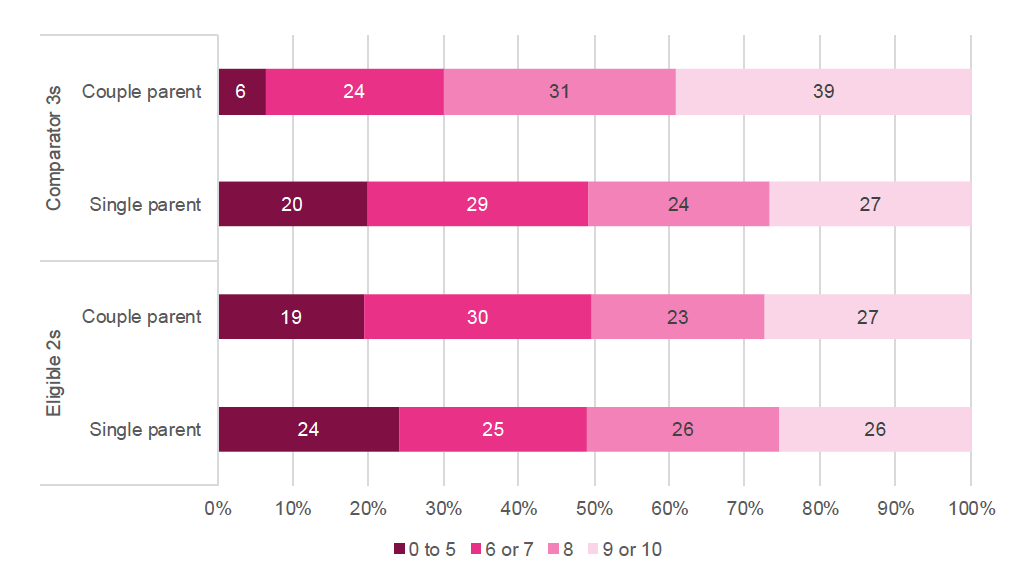
Base: All respondents (parent questionnaire Phase 3, Eligible 2s unweighted, Comparator 3s weighted)
Figure 33: Banded life satisfaction, by household type, Eligible 2s and Comparator 3s, Phase 3 Description. This stacked bar chart shows the banded life satisfaction scores for the Eligible 2s and Comparator 3s by household composition. Among the Comparator 3s, 20% of single parents, compared with 6% of couple parents scored their life satisfaction as 0 to 5, while 39% of couple parents, compared with 27% of single parents scored 9 or 10. Levels for Eligible 2s were similar to those for single parents among the Comparator 3s.
Parents were asked how they felt they were coping as a parent. Figure 34 shows the responses of both groups. Parents in the Comparator 3s group were more likely to say they were coping well most or all of the time (73% compared with 57% of the Eligible 2s). There were no clear differences between socio-demographic subgroups in either of the main groups in terms of the proportion coping well.
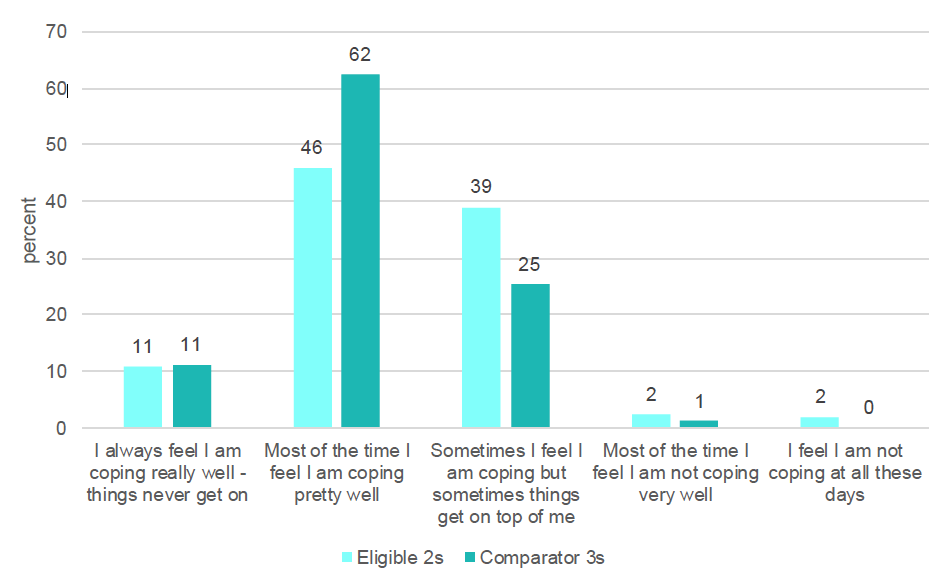
Base: All respondents (parent questionnaire Phase 3, Eligible 2s unweighted, Comparator 3s weighted)
Figure 34: How coping as a parent, Eligible 2s and Comparator 3s, Phase 3 Description. This clustered column chart shows 73% of parents in the Comparator 3s group said they were coping well most or all of the time, compared with 57% of the Eligible 2s. 1% of parents in the Comparator 3s group and 2% of the Eligible 2s said that most of the time they were not coping well, and 0% of parents in the Comparator 3s group and 2% of the Eligible 2s said that they are not coping at all.
Parents were also asked a series of questions on the effect that access to childcare had on activities they had undertaken and on their general wellbeing. While the general picture in much of the analysis included in this report has shown that things tend to have improved for the Eligible 2s and their parents between Phase 1 and Phase 3, there is still some way to go in terms of closing the gap with the nationally representative sample of Comparator 3s. However, this series of questions shows some very positive findings for the parents of the Eligible 2s in terms of what parents have been able to do and how they have been feeling because their child is in nursery.
As can be seen in Figure 35, parents in the Eligible 2s group were more likely than those in the Comparator 3s group to agree with all of the statements with the exception of those to do with study or paid work. They were more likely to say they had been feeling happier as a result of having their child in nursery (51% compared with 42% of the Comparator 3s), that they had been feeling less stressed (58% compared with 42% of the Comparator 3s), that they had more time to themselves (72% compared with 63%) and that they were able to think about what they may do in the future (71% compared with 57%). The largest difference between the two groups was in the proportion who had been able to care for other family members (57% of the Eligible 2s compared with 35% of the Comparator 3s).
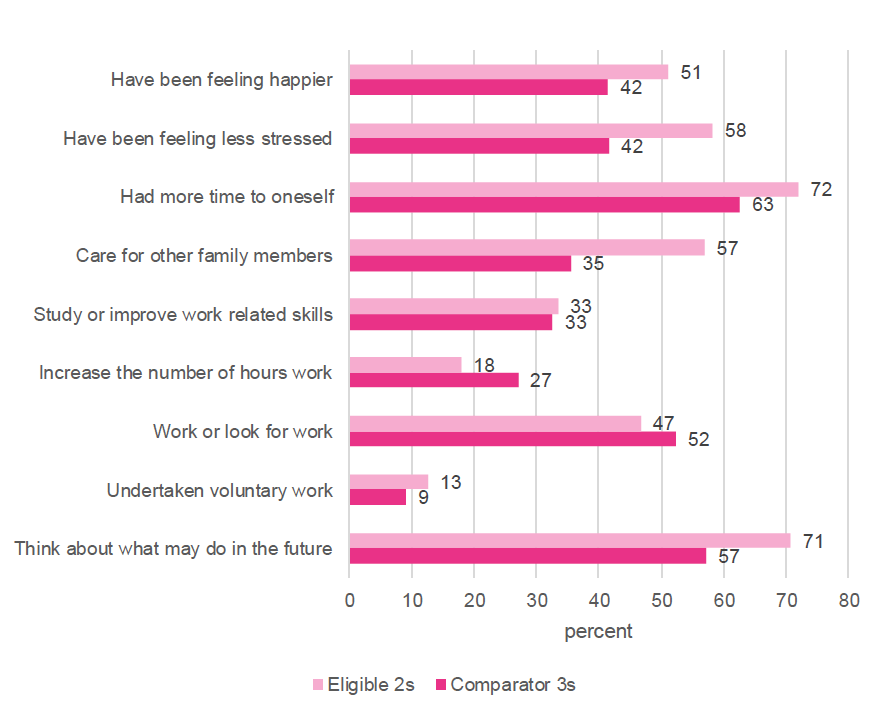
Base: All respondents (parent questionnaire Phase 3, Eligible 2s unweighted, Comparator 3s weighted)
Figure 35: Proportion agreeing with activities done/perceived change in feelings because child is in nursery, Eligible 2s and Comparator 3s, Phase 3 Description. This bar chart shows whether parents agreed or disagreed with statements reflecting activities done / perceived change in feelings because of their child being in nursery for Eligible 2s and Comparator 3s.
Figure 36 provides a breakdown of responses to each of the statements by household composition for the Comparator 3s. For the questions about thoughts and feelings, there tended to be a significant difference between those in the top three income quintiles and those in the bottom two, with those on lower incomes benefitting more from having their child in nursery. For example, half (50%) of those in the bottom two income quintiles agreed they were feeling less stressed, compared with 37% of those in the top three quintiles. More than half (59%) of those in the bottom quintile had been feeling happier, compared with 36% of those in the top three quintiles. Three quarters (70-75%) of those in the bottom two quintiles had more time to themselves, compared with 55% of those in the top three quintiles. And two thirds (66-71%) of those in the bottom two quintiles had been able to think about what they may do in the future, compared with 51% of those in the top three quintiles. There was also a significant difference in the proportion who agreed they had been able to care for other family members (42-43% in the bottom two quintiles compared with 30% in the top three). Differences in the work related questions were not significant.
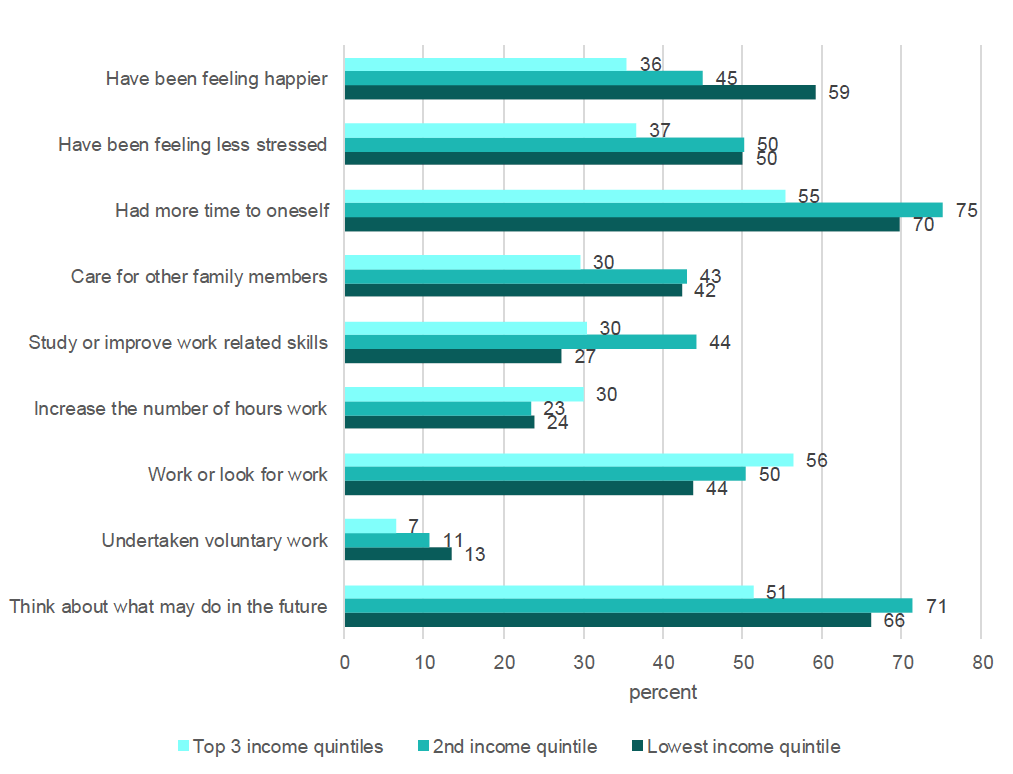
Base: All respondents (parent questionnaire Phase 3, Comparator 3s weighted)
Figure 36: Proportion agreeing with activities done / perceived change in feelings because child is in nursery, by equivalised household income, Comparator 3s, Phase 3 Description. This clustered bar chart shows whether parents of Comparator 3s agreed or disagreed with statements reflecting activities done / perceived change in feelings because of their child being in nursery broken down by equivalised household income.
Tables C26 to C29 in Appendix D show the same information broken down by area deprivation, highest level of education, one- or two-parent household and by the total difficulties score of the Strengths and Difficulties Questionnaire. In general, the pattern for the Comparator 3s was similar to that for income, in that those with lower levels of education, in single parent households and living in more deprived areas appeared to benefit more in terms of feeling happier, less stressed, having more time to themselves and being more able to think about the future, although there tended to be fewer significant differences. Differences with respect to the SDQ total difficulties score tended to be small and not significant, with the only noticeable difference being for the Comparator 3s in the proportion agreeing that they had been able to think about what they may do in the future, with those with a child with a high or very high score tending to benefit more than those with children who had a close to average score.
Contact
Email: socialresearch@gov.scot
There is a problem
Thanks for your feedback